14 Types of Barrel Cactus for a Unique Landscape
Author: Jen Worst | Editor: Omar Alonso
Review & Research: Jen Worst & Chris Miller
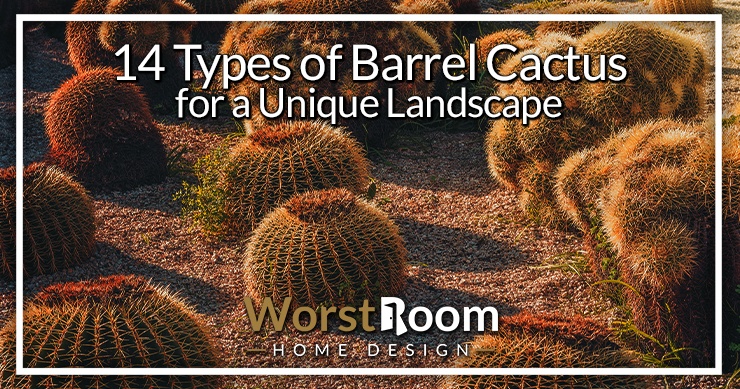
The barrel cactus is native to the US and Mexico. This family of spiny plants produces beautiful flowers, and they're ideal for low-maintenance, low-water gardens. Visit the Mojave Desert and you'll find these types of barrel cactus growing in abundance.
The barrel cactus is an excellent houseplant suitable for sustainable landscaping projects in water-deprived gardens and has a cylindrical or tubular shape. They love the heat and thrive in hot climates.
14 Types of Barrel Cactus
There are more than 30 varieties in the Ferocactus genera, and this post gives you our top 14 choices for your indoor or outdoor garden. These types of cactus grow fast and don't require much maintenance, making them ideal for homeowners who want to spruce up their yards or living areas without extensive plant care.
Devil's Tongue (Ferocactus latispinus)
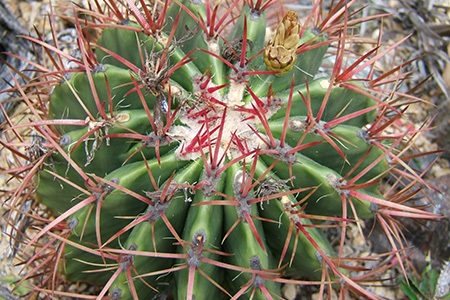
The Devil's Tongue is a hardy cactus, producing some of the most beautiful flowers in the barrel cactus family. This variety features grey ribs with a slight hint of blue in the plant, which is simply mesmerizing.
The orange/red spines are beautiful and contrast the dark pink flowers produced in the summertime. The flowers sit atop the spines, providing an attractive viewpoint in any indoor garden or outdoor flowerbed.
These indoor cactus types love loamy, loose soil and basking in direct sunlight all day. The flowers come out in the late spring to early summer.
Horse Crippler (Echinocactus texensis)
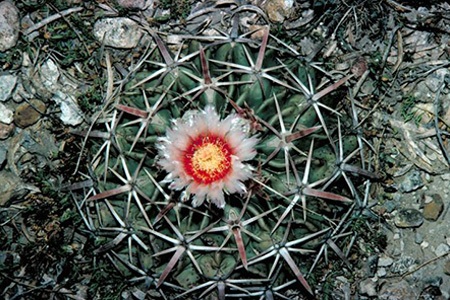
These barrel cactus types gets their moniker from their low profile, making it easy for horses to miss when walking along the sandy desert trails. The small but sturdy spines can essentially cripple a horse, creating a painful sting that incapacitates the animal.
It's a low-growing variety that likes to spread out, featuring wide ribs and sharp, short fishhook-style spines. The Horse Crippler also goes by the nickname "The Devil's Head." It's a hardy variety and loves growing in partial shade, making it a great choice for indoor and outdoor gardens.
This variety needs more water than other cacti to thrive, doing well in soil that drains well and offers plenty of airflow to the roots. The Horse Crippler's fruits are red, producing pink blooms in the summer months.
Red-Spined Barrel Cactus (Ferocactus chrysacanthus)
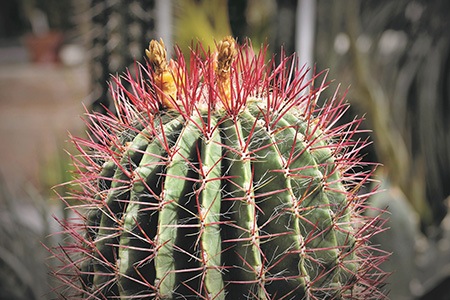
If you want a set-it-and-forget-it cactus that doesn't require repotting every year, consider the Red-Spined Barrel Cactus. This variety features attractive red spines and comes in colors ranging from green/grey to yellow, depending on its region.
It's a slow-growing variety and only requires repotting every three to four years, making it the ideal low-maintenance cacti for the indoor gardener. The ribs are fleshy and thick, and it produces plenty of spines. The Barrel cactus has pretty yellow flowers blooming from its crown.
Turk's Head (Ferocactus hamatacanthus)
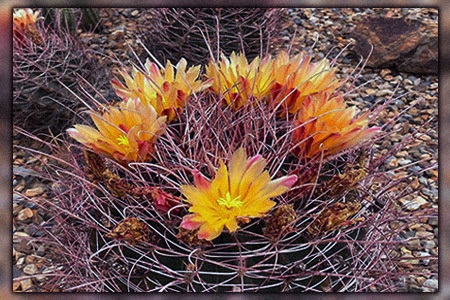
The Turks Head is a spiny variety, with each rib featuring over a dozen white, red, or yellow spines. It's one of the rarest types of barrel cactus out there and is highly sought-after by indoor gardeners.
The Turks Head can withstand cold temperatures in USDA Zones 6a (but prefers 8b to 10b) and enjoys growing in indirect sunlight conditions. It enjoys growing in alkaline soils with pH levels of 8.0. The cactus blooms large flowers measuring two to three inches in diameter from July through September.
Clump Barrel Cactus (Ferocactus robustus)
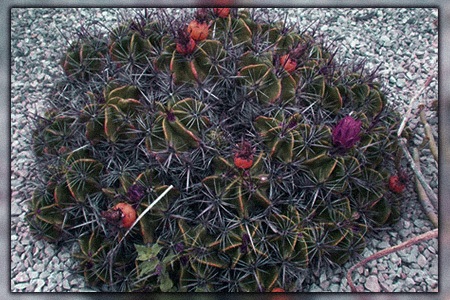
This is one of the largest varieties in the barrel cactus family. It loves spreading its branches, with some plants growing up to ten feet wide, producing hundreds of branches. The spines grow from the ribs, but the size/rib/spine ratio is low compared to most barrel cactus varieties.
The Clump Barrel Cactus produces bright green, fleshy branches and blooms in the spring or early summer, producing orange and yellow flowers. This cactus thrives in gravel-rich soils that drain well. Leaving it in the full sunlight results in fast growth, especially when adding a little liquid fertilizer to the soil during the summer.
Coville's Barrel or Emory's Cactus (Ferocactus emoryi)
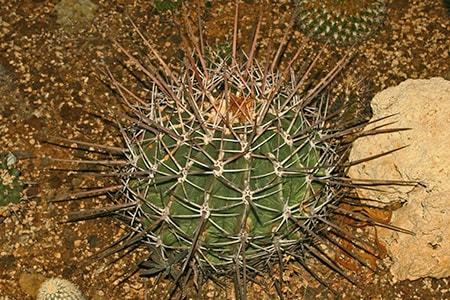
This Coville's Barrel Cactus has several names, including the "Sonora Barrel" and "Emory's Cactus." This desert variety thrives in direct sunlight but grows in the shade, just not as fast. The Coville likes warm weather, preferring to call the USDA Zone 9a to 11b regions it's home.
The Coville does well in rocky soils that drain well, allowing optimal airflow to the roots. The orange/yellow blooms turn a deep red as the summer progresses, and it's a real stunner for the garden. This cactus features a stem, rib, and rib structure that looks alien, giving it a unique look. The cactus produces a limited number of purple spines.
Santa-Maria Barrel Cactus (Ferocactus Santa-Maria)
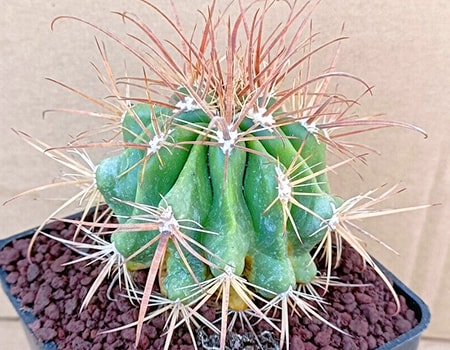
The Santa-Maria Cactus is native to Mexican deserts and thrives in the full sun and summer heat. The cactus blooms in the late spring, with the flowers lasting until mid-June. Like the California cacti family, the Santa Maria enjoys growing in well-drained, rocky soils. You can use it in an indoor garden, but it requires gravel soils to do well.
Garners state this cactus is the mid-ground between the Turk's Head and the San Diego. It grows taller but has fewer, longer spines than the other varieties. The spines are brown on the outside, with the center spines having a dark red color with an orange/yellow tint.
Townsend Barrel Cactus (Ferocactus townsendianus)
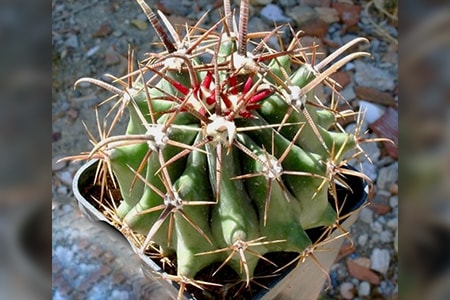
This variety blooms in the late summer and likes growing in loose, rocky soil that drains well. It can grow in direct sunlight or shade, providing it gets a minimum of five to six hours of sun daily. It's a good choice for indoor gardens that are close to windows. You won't need large types of planters either.
These types of barrel cactus are a dwarf variety, reaching heights of 20 inches in height and spreading up to 12 inches in diameter. It's a slow-growing variety and likes drinking more water than other cacti in the barrel family. Like most, when you're done with them (as long as they aren't endangered) you can kill the cactus growth using a simple procedure.
Golden Barrel (Echinocactus grusonii)
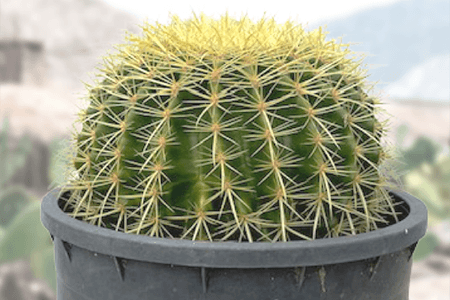
This green barrel cactus species produces golden-yellow flowers that appear in April and last throughout the summer months. The spines are also yellow, creating a stark contrast against the green skin. It's a desert species and thrives in hot climates, typically in USDA Zones 9 to 12.
Add perlite and sand when planting to ensure good drainage and plenty of airflow to the roots. While the Golden Barrel is one of the most popular cultivated varieties, it's also endangered.
Fishhook Barrel Cactus (Ferocactus wislizeni)
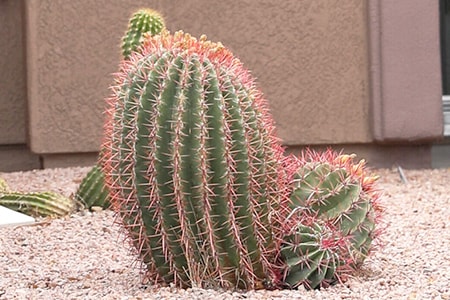
The Fishhook is one of the most desired and beautiful ornamental cacti in the United States. The spines are somewhat dull, but the orange-red flowers are a real attention-grabber. The blooms pop out on the top of the stems in a circular fashion. The flowering season is between mid-April to June.
The Fishhook has a slight curve in the stem, usually leaning to the south. It starts off round and gets more tubular as it matures. It's another desert species that thrives in gravel-type soil, offering good drainage. The Fishhook can thrive in direct sunlight or partially shady conditions.
Texas Blue Barrel (Ferocactus glaucescens)
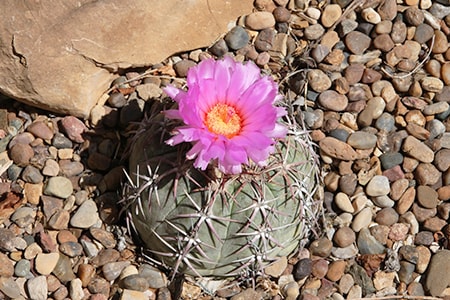
Also known as the "Glaucous Barrel Cactus," the Texas Blue types of barrel cactus gets its moniker from its deeply-ribbed, blue-colored stems. The flowers and spine in this variety are golden-yellow, blooming from early May to the end of June.
The short spines are very sharp, so don't let them fool you; take caution with them. Its cylindrical shape is attractive, spreading to a 2-foot diameter, and it kind of looks like a pumpkin. The Texas Blue suits indoor and outdoor gardens but requires a minimum of three to four hours of direct sunlight daily to thrive.
San Diego Barrel Cactus (Ferocactus viridescens)
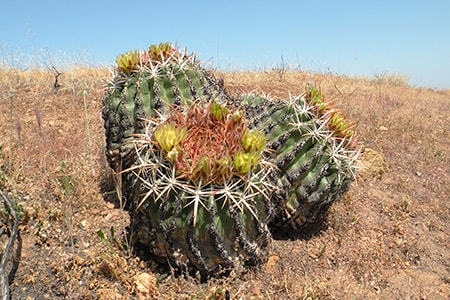
The San Diego Cactus loves growing in loamy, sandy, or rocky terrain. It prefers acidic soil in the pH range of 5.5 to 5.2 and exposure to direct sunlight to do well. Its hardy nature and love of the heat make it ideal for growing in USDA Zones 9b through 11b.
You can grow the San Diego indoors or outdoors, and it's a rare wild species. Its wide, thick ribs feature plenty of spines that turn a golden-yellow or red color.
California Barrel Cactus (Ferocactus cylindraceus)
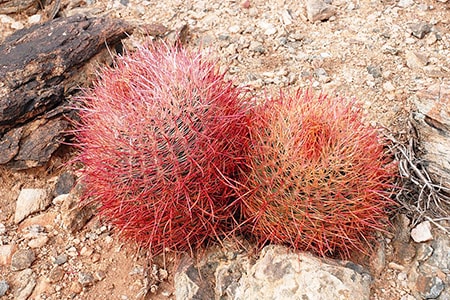
Also known as "The Desert Barrel," the California Barrel Cactus" is native to the arid regions around Nevada, California, Arizona, and Utah. It grows up to 8 feet tall, making it suitable for outdoor gardens only. The tubular stems present reddish/yellow spines, and the fruits and flowers are also yellow in color.
The California prefers growing in direct sunlight, but it can cope in the shade provided it gets six to eight hours of direct sunlight during the day. This cactus loves the heat and thrives in USDA Zones 9a or higher.
It can't handle the cold and prefers growing in fertile, well-drained, sandy, or rocky soils with neutral acidity. The flowers bloom in April and stick around for two to four weeks.
Cottontop Barrel Cactus (Echinocactus polycephalus)
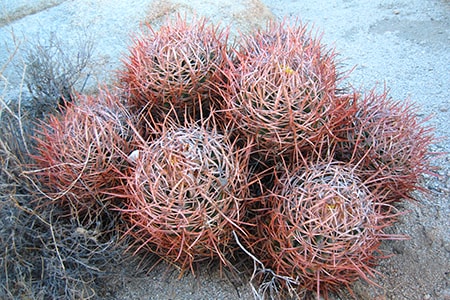
Our final choice is something quite extraordinary – The Cottontop. This cactus grows in a cluster structure, producing up to 200 barrels roughly eight to 10 inches in diameter.
The spines are reasonably long, and there are many of them, making it hard to see the stems. This variety produces yellow flowers.
Types of Barrel Cactus for Any Lawn or Garden
If you live in the right zones and want to explore some more unique options rather than trees, shrubs, and flower beds, then these types of barrel cactus might be right up your alley. If you’re an enthusiast then you can find even more in the Ferocactus genus or can venture outside of it as well. Have fun!



